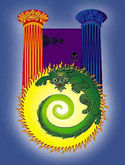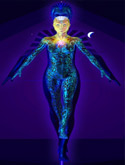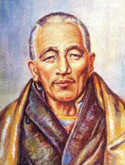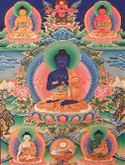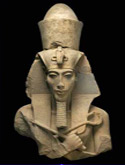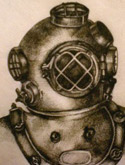Sagittarius 2014: The Adventurer. The Odyssey: Journey of Ulysses.
 Keynote
Keynote
“I see the goal. I reach the goal and see another.”
(Full Moon: December 6, 2014. 12.26 pm GMT.)
“… The Archer has to acquire and hold a steady eye, hand and stance
prior to firing the arrow which, when rightly directed and correctly
followed, will carry him through the portal of initiation.
Those nearing the path of discipleship or already disciples,
will profit much from a deep and systematic study of this sign.”1
Sagittarius the Adventurer
The Odyssey: Journey of Ulysses
The Lotus Eaters
The Cyclopes
Circe the Sorceress
The Sirens
Calypso
Penelope, Her Suitors and the Return of Ulysses
Sagittarius the Adventurer
Sagittarius is the intrepid and daring venturer into undiscovered realms; those remote places at the furthest reaches of the Earth – upon mountain summits, in distant jungles or lonely deserts. Or, in consciousness, at the forefront of scientific exploration, pushing the boundaries of artistic expression or probing the soul in deep meditation.
Sagittarius is boundless expansiveness, a description befitting its ruler Jupiter, the largest planet in our solar system — and ruler of the second ray of Love-Wisdom, the indigo ray of teaching and healing.

Somewhere in Utah. USA’s exoteric horoscope is Sagittarius rising. Krishnamurti (Sagittarius Moon) liked western movies because of their beautiful scenery.
Sagittarius is the fiery archer who dares to go beyond her own circumscribed radius. At one stage of evolution, she fires her arrows toward unknown destinations, to see where they lead; her arrows are sent forth by thought, waiting for the returning arrow of intuition. Sagittarius is the spirit of discovery, hence the explorer, adventurer, enquirer, wanderer, traveller — and Star Trekker:
“Space: the final frontier. These are the voyages of the starship Enterprise. Its five-year mission: to explore strange new worlds, to seek out new life and new civilizations, to boldly go where no man has gone before.”2



L: The Enterprise. M: Dr. Spock, Vulcanite. R: Latest Hollywood saga.
Space (consciousness), the final frontier.
| “The exploration of inner space, our own consciousness, is ultimately connected to our discovery of outer space. Just as the world becomes a smaller place with increase in communication and transport technology, so the universe becomes a smaller place with the increase in meditation technology!” ~ Dada Gunamuktananda ~ |
Hence, Sagittarius is the dreamer, the speculator and the visionary — a mix of imagination, directed thought and intuition:
 “In Sagittarius, the intellect which has been developed, used and finally illumined, becomes sensitive to a still higher type of mental experience and to this we give the name of intuitive perception. There come flashes of light upon problems; a distant yet possible vision of attainment is seen; the man begins to climb out of the depths to which he has descended in Scorpio and sees ahead of him the mountain in Capricorn -which he knows he must eventually climb.”3
“In Sagittarius, the intellect which has been developed, used and finally illumined, becomes sensitive to a still higher type of mental experience and to this we give the name of intuitive perception. There come flashes of light upon problems; a distant yet possible vision of attainment is seen; the man begins to climb out of the depths to which he has descended in Scorpio and sees ahead of him the mountain in Capricorn -which he knows he must eventually climb.”3
This reference to Sagittarius between Scorpio and Capricorn is interesting, because Sagittarius (like Libra), is noted as a sign of “interlude” — between the tests and trials of Scorpio and the possibility of attaining initiation on the summit of Capricorn.
Although Sagittarius is the one-pointed Archer, it is paradoxically a sign of duality, especially emphasised by the fact that its polar opposite sign is Gemini, The Twins. The ancient symbol for Sagittarius is the Centaur, representing ambition, whilst The Archer is about aspiration and direction. The former is personality oriented, whilst the latter is of the soul; hence the Centaur and Archer represent the duality of Sagittarius.
 The Centaur is half-man, half-horse, representing the animal desire nature that still has not been overcome, influenced by kama-manas (desire-mind), the satisfaction of personality ambition to achieve a goal. The Archer’s main theme is one of Direction — refocussing oneself toward a specific objective that is aligned with the Divine Plan — or at least a relative understanding of one’s role:
The Centaur is half-man, half-horse, representing the animal desire nature that still has not been overcome, influenced by kama-manas (desire-mind), the satisfaction of personality ambition to achieve a goal. The Archer’s main theme is one of Direction — refocussing oneself toward a specific objective that is aligned with the Divine Plan — or at least a relative understanding of one’s role:
“When this faculty of sensitive direction is rightly developed, it becomes in the early stages, an effort to identify all soul and personality activity with God’s Plan, and this is … the ordered direction of God’s thought. There is no true direction apart from thought … thought is power … mental direction.
Upon the reversed wheel [Sagittarius upon the lighted Way], the goal is the expression of love-wisdom [Jupiter] and this is ever selflessly developed and always consecrated to the good of the whole – and not to the satisfaction of the individual.”4
Hence, the awakened Sagittarius grasps her part to play in the greater Plan,
“He walks no longer in the dark, for he sees what he has to do and he therefore makes rapid progress and travels “fast upon the Way.” He “flies from point to point, searching for the arrows which he has discharged.”
He has, figuratively speaking, to dismount constantly from his white horse (the developed and purified personality) and find where the arrows of intuitional aspiration will take him; he travels upon the “wings of the soul” … and becomes, in his own personality, himself the winged God.”5


L: Note the solar disc, “Mercury and the Sun are one.” R: The wings of the soul surmount the caduceus.
Note the reference to Mercury, “the winged God” who, as a “messenger of the gods”, mediates between soul and personality, keeping equilibrium and balance. Mercury rules the opposite sign of Gemini, hence, when Sagittarius becomes a “winged god”, it has successfully blended the Gemini-Sagittarius duality.
Keeping balance is not always an easy task for Sagittarius — or the mutable cross signs in general, of which it is part. When the airy Gemini is linked with fiery Sagittarius, the image of a volatile fire emerges, fierce flames at the mercy of a fickle wind; this is Sagittarius at the unawakened stage of development, not the awakened Archer directing fiery arrows to the target. Flames and weapons are the province of Mars, hierarchical ruler of Sagittarius.
It is the Mars influence here that contributes greatly to the emotional volatility of Sagittarius. It is through the Mars influence in Sagittarius, that the disciple upon the way is tested, concerning:
“… the lunar lords of the form nature who must eventually be sacrificed to the higher spiritual aspect and brought under the control of the solar Angel.”6 (See this newsletter for the potent Mars influence in Sagittarius.)
Whilst on the subject of Mars, students would profit from tracing the evolution of Mars through the signs, for instance, its position upon the four arms of the cardinal cross — in exaltation (Capricorn), fall (Cancer), dignity (Aries) and detriment (Libra).
Similarly, Mars in a sequence of signs from Virgo to Sagittarius: Virgo (‘quickening’ of the soul life), Libra (god of war in sign of peace), Scorpio (ultimate testings and trials), Sagittarius (hierarchical ruler) and Capricorn (the struggle between the spiritual and material).


In the practice of Esoteric Astrology, not only must the polar opposite of a sign be considered, but the entire cross associated with a sign. Always under consideration as well, is the relative stage of unfoldment of any individual or group, which the following table illustrates,
| Unawakened Humanity | Awakened Humanity |
| Gemini—Changeableness. Instability. Interplay. | Gemini—Recognition of soul and form. Soul interplay. |
| Sagittarius—Ambitious desire. Direction. Orientation. | Sagittarius—One-pointed spiritual aspiration. Disciples. |
| Virgo—Material life. The cherishing of an idea. | Virgo—The mother of the Christ Child. Gestation. |
| Pisces—Sensation. Mediumship. Fluidity. | Pisces—The world Saviour. Mediatorship. |

Mercury and Jupiter are the two dominating rulers of the mutable cross signs, ruling respectively Gemini-Virgo and Sagittarius-Pisces. Both planets rule the second ray of Love-Wisdom and the fourth ray of Harmony through Conflict, the rays that rule over the mass of humanity:
“Their function is to fuse and blend into one cooperative whole, the great dualities expressing themselves through the fourth kingdom [human] in nature. The significance of this will be obvious. It is easily apparent how, through the influences of Mercury and Jupiter, material desire can be transmuted into divine love, and the conflict which is the distinguishing characteristic of the human family can be instrumental in resolving dissonance into harmony.”7


The link between archery and Zen Buddhism is ancient, symbolic but also
a physical discipline for directing thought and controlling the mind in meditation.
The Odyssey: Journey of Ulysses

Ulysses Defying the Cyclopes.
(Louis Frédéric Schützenberger 1825-1903.)
In Ancient Greece, the Mysteries of Initiation were encoded in myth and legend. Homer’s epic poem, The Odyssey, is the story of King Odysseus (or Ulysses in Roman myths) — and his extensive travels for many years around the world; it is the story of The Quest, par excellence – the adventurer and world-weary traveller seeking the Sagittarian goals of wisdom and truth.
The Odyssey is Humanity’s search for the soul, with its many trials and tests along the way, the ceaseless wandering that eventually leads Ulysses back home, to reunite with his wife Penelope — the personification of Wisdom, the soul. His absence from home for twenty years (20=2), is also symbolic of the development of the second ray of Love-Wisdom. Similar stories abound, such as the return of the Prodigal Son, the Wandering Jew, the Labours of Hercules, Jason and the Argonauts, and Sinbad the Sailor.



More modern odysseys, yet still the timeless Quest. Indiana Jones: Archetypal Sagittarian.
Libran artist, Nicholas Roerich, had extensive travels whilst his progressed Sun was in Sagittarius.
The adventures of Ulysses commenced after the Trojan War, esoterically a far more ancient time in history than is otherwise recognised. The Odyssey is similar to the ancient Hindu Ramayana, an event that occurred around the beginning of the Fifth Rootrace, when Atlantean consciousness was still highly influential. The civilisation of Atlantis was sunk by vast floods that covered the entire planet, hence the ubiquity of Neptune, Lord of the Oceans, as Ulysses sails around the world with his loyal crew, through one adventure after another. Hence also, the nature of the testings of the watery desire nature, Neptune ruling the astral realm and the fogs of maya and illusion.
According to Manly P. Hall and his Neo-Platonic interpretation of The Odyssey, Neptune is patron over the psychic life and does not wish Ulysses to escape. Neptune is the fluidity of the astral life, played out upon the oceans of Ulysses’ travels, causing him the gravest doubts. Neptune is the co-ruler of the sixth ray of Devotion or Idealism, and Sagittarius is the most potent expression of the sixth ray in this cycle, driven by Mars’ hierarchical rulership of this sign. Both planets rule the solar plexus centre, seat of the astral body.
Ulysses’ journey represents the struggle to free himself from the still very potent influence of the Atlantean civilisation, whilst developing the mental control characteristic of the new race emerging at that time, our current fifth rootrace. Yet, the story is contemporary — it is the recapitulation of that ancient struggle today, for everyone on their personal Odyssey, hearkening to the call of the soul — and the greater group or ashram with which they are affiliated. These myths are universal, timeless and always a richly rewarding key that unlocks The Mysteries.
The ocean is regarded as the journey between earth and spirit. It is the mediating principle from the lower or higher perspectives — as the astral plane between the physical and mental, or the soul bridge between spirit and matter. As ruler of the astral plane, Neptune in its not-entirely-redeemed aspect, represents the “snare of imagination” — that makes it difficult to think clearly, to restore a mental balance.


The problem of Neptune here is a double-edged sword: Imagination is the lower reflection of intuition or buddhi, the highest expression of Neptune; yet a morbid imagination8 harbours many of the glamours, illusions and pitfalls of the astral plane. This is what Hall means by the “snare of imagination”.
When imagination is combined with the highly speculative nature of Sagittarius (Don Quixote tilting at windmills)9, it is capable of great artistic expression, or can foster fears and illusions. Yet, this is what motivates the Archer to shoot her arrows beyond her circumscribed radius; this is the creative imagination at the heart of Vajrayana meditation — and the nature of the “razor-edged” Path to enlightenment.
In The Odyssey, Minerva — the goddess of wisdom is usually depicted with an owl, representing the spiritual guidance of the higher mind or of Ulysses’ soul, that eventually guides his escape from Neptune’s “snares”. Minerva’s name is derived from the root “men”, meaning mind (like the Sanskrit manas). One of her best-known qualities is high intelligence, like her counterpart, Pallas-Athena.



Ulysses – or Odysseus, was also called “Odysseus the Cunning”, renowned for his brilliance, guile and versatility — a “cunning intelligence”. This is symbolic of the well-developed mind as a most potent component of the three-fold personality or lower self, yet also the Dweller, the shadow — clever and arrogant, full of worldly knowledge, though not balanced with wisdom.
Ulysses had many adventures and a few highlights will be considered in the following. Note that many of his encounters are with supernatural beings, the deva kingdom — which was much closer to humanity than today, and with now extinct giants.
Sagittarius is one of the great story-telling-poet signs of the zodiac, especially combined with the fourth ray of Beauty and Art.
Sun in Sagittarius: Mark Twain, Louisa May Alcott, Rainer Marie Rilke, Alexander Solzhenitsyn, William F. Buckley.
Sagittarius rising: Fyodor Dostoyevsky, Herman Hesse, John Galsworthy, Philip Roth, Kurt Vonnegut, H.G. Wells.
Likewise, Sun in the opposite sign Gemini — Dante Alighieri, Allen Ginsburg, Edward Bulwer Lytton, Thomas Mann.
The Lotus Eaters
On the way home from Troy, Ulysses and his twelve ships were driven off course by storms, visiting the lethargic Lotus-Eaters:
“… the Lotus-eaters, who live on a food that comes from a kind of flower. Here we landed to take in fresh water, and our crews got their mid-day meal on the shore near the ships … They started at once, and went about among the Lotus-eaters, who did them no hurt, but gave them to eat of the lotus, which was so delicious that those who ate of it left off caring about home, and did not even want to go back and say what had happened to them, but were for staying and munching lotus with the Lotus-eaters without thinking further of their return.”10



The lotus fruits and flowers were narcotic, making people sleep in a kind of peaceful apathy. Here is the expression of Neptune who rules over drugs and their illusory nature. In the development of consciousness, the spiritual centres or lotuses, are opened over a period of many lifetimes, yet these people were “eating lotuses” — postponing their spiritual development.
This interlude represents a somewhat Gemini distraction for the one-pointed Sagittarian quester; or perhaps, in considering the whole mutable cross, a dreamy Piscean interlude. In modern day terms, a “lotus-eater” is a person who leads a life of indolence, indifferent to the busy world, a daydreamer or an unrealistic idealist.
The Cyclopes
The Cyclopean giant Polyphemus captured Ulysses and started eating his men. Ulysses obtained a barrel of wine and the giant drank it, falling asleep. Ulysses and his men took a wooden stake, igniting it with the remaining wine and drove it into one of his eyes, blinding him.



H.P. Blavatsky (HPB) states in The Secret Doctrine, that the three one-eyed Cyclopes of Greek Myth, represent the last three subraces of the Lemurian, or third rootrace. Hence, the blinding of Polyphemus is connected to the extinguishing of remaining vestiges of Lemurian consciousness — at that critical period of emerging Fifth Rootrace consciousness. HPB tells us:
“The allegory of Ulysses, whose companions were devoured while the king of Ithaca was saved — by putting out with a fire-brand the eye of Polyphemus, is based upon the psycho-physiological atrophy of the “third” eye. Ulysses belongs to the cycle of the heroes of the Fourth Race [Atlantis] … His adventure with the savage gigantic race, the antithesis of cultured civilization in the Odyssey — is an allegorical record of the gradual passage from the Cyclopean civilization of stone and colossal buildings to the more sensual and physical culture of the Atlanteans, which finally caused the last of the Third Race to lose their all-penetrating spiritual eye.”11
In another adventure, Ulysses encountered the cannibalistic Laestrygonians, who the Greeks regarded as having inhabited Sicily at one time. HPB further comments,
“The Læstrygonians, who devoured the companions of Ulysses, are traced to the huge cannibal race, said in primitive days to inhabit the caves of Norway. Geology verified through her discoveries some of the assertions of Homer, supposed for so many ages to have been but poetical hallucinations … The Norwegian fiords are perfectly described by Homer in his Odyssey, x. 110; and the gigantic stature of the Læstrygonians is demonstrated by human bones of unusual size found in caves situated near this region, and which the geologists suppose to have belonged to a race extinct long before the Aryan immigration.”12
Circe the Sorceress
“Ulysses was wrecked on the isle of Ææa, where Circe changed all his companions into pigs — for their voluptuousness … [their over-indulgence in pleasure].”13
Circe was the daughter of Helios, the sun. Her brothers were Aetes, the keeper of the Golden Fleece (symbol of the causal body of the soul), and Perseus. Her sister was Pasiphae, wife of King Minos of Crete (The Manu) and mother of the Minotaur.
When Ulysses met Circe, she turned half of his men into swine after feeding them cheese and wine. Hermes (Mercury) warned Ulysses about Circe and gave him a drug to resist Circe’s magic. Circe was attracted to Ulysses’ resistance, fell in love with him and finally released his men.


Circe changing Ulysses’ men into beasts. (Note her books on magic.)
According to M.P. Hall, Circe represents the uncontrolled imagination. Ulysses deceives himself through the impulses his own desires, false doctrines and beliefs, lunar principles, the astral plane, pseudo-psychic phenomena — all of which feed frustrations and phobias. Here also, are some of the glamours of Sagittarius and the sixth ray — being a one-eyed believer in some religious or philosophical doctrine. One of the fascinating paradoxes of Sagittarius is its love of broad and boundless ideas, versus a one-pointed, narrow fundamentalism that is stuck on one track.
Humanity has often had a recalcitrant unwillingness to face facts, it would rather live in self-created illusions. Only the one-pointed mind can reach the destination, all else must be left behind, hence the eventual departure from Circe and her island.
The Sirens
One of the most (in)famous stories of The Odyssey. Ulysses orders his crew to tie him to the mast so he can hear the sweet sound of the sirens without falling prey to them. (Note the many “femme fatales” and the theme of sex Ulysses encounters in his travels.) A seiren song is, “an alluring utterance or appeal; especially one that is seductive or deceptive.”
There is much esotericism in this story, not least the relationship of humans with the deva kingdom, or the existence of mermaids or fish-like beings from an earlier evolution. But also, seiren is from the Greek Seirios for the star Sirius — the “sound” of the star Sirius, whose transmitted frequencies guide the evolution of our entire solar system.



Calypso and Ulysses.
Calypso
“Ulysses … was thrown into Ogygia, the island of Calypso, where for some seven years he lived with the nymph in illicit connection. Now Calypso was a daughter of Atlas and all the traditional ancient versions, when speaking of the Isle of Ogygia, say that it was very distant from Greece, and right in the middle of the ocean: thus identifying it with Atlantis.”14

Fête de Calypso pour Ulysses. (Brueghel – 1616.)
Calypso was a nymph in Greek mythology (a member of the deva kingdom), who lived on the island of Ogygia. She was the daughter of Atlas, who as the name implies, is Atlantis personified:
“The Greek allegories give to Atlas, or Atlantis, seven daughters (seven sub-races), whose respective names are Maia, Electra, Taygeta, Asterope, Merope, Alcyone, and Celæno. This ethnologically, as they are credited with having married gods and with having become the mothers of famous heroes, the founders of many nations and cities.
Astronomically, the Atlantides have become the seven Pleiades. In occult science the two are connected with the destinies of nations, those destinies being shaped by the past events of their early lives according to Karmic law.”15
Ulysses was washed ashore on the island of Ogygia, where Calypso compelled him to remain as her mortal lover for seven years (a Saturn cycle). She enchants him with her singing as she weaves at her loom (like Penelope), with a golden shuttle. They sleep together but Ulysses soon wishes for changed circumstances. Calypso’s intention was to make Ulysses her immortal husband, but it was not his destiny to live with her forever – he finally escaped after Hermes told her to release him.


Scenes from Pirates of the Caribbean. L: Neptune’s vortex. R: Calypso. The Carribean area is one of the major remnants of the Atlantean continents, particularly Atlantis in its decline, with the abuse of magic and the problem of theft. Hence, legends of the Bermuda Triangle, mysterious disappearances, voodoo etc.
Penelope, Her Suitors and the Return of Ulysses
This is probably the most important part of the story, as Ulysses returns to reunite with Penelope – the wandering personality returns redeemed and reunites with the soul. During his absence, Penelope devised many strategies to delay marrying one of the 108 suitors. (Note this number with regard to the 108 Kumaras, 108 prayer beads, the fifth harmonic etc.)
These were ambitious men that wanted to marry Penelope, representing worldly knowledge selfishly motivated by power and prestige to marry wisdom. Penelope rejected their advances and set them impossible tasks. She would not marry until her weaving was done, so she unravelled her weaving every night, making certain that the weaving would never be finished.


L: Penelope at her loom, yearning for Ulysses’ return. R: Unravelling her weaving at night.
(One of the main symbols of the third ray of Active-Intelligence is “The Weaver”.)
M.P. Hall comments that no matter how much we know, something at night takes out that learning, and must weave it again the next day; we can never know all. (Sagittarius is well known for being a know-all!) No matter how much we “woo wisdom”, we cannot attain its completeness and therefore cannot fulfil its requirements. Therefore, in order to protect wisdom, wisdom forever unravels what it has done, so those with selfish intention can never harm wisdom.
Penelope was able to confound her suitors until Ulysses returned — her true husband. Here lie many unifications — male-female, yin-yang, soul-personality etc. Ulysses restored his own inner knowledge of the wisdom that was always his — by returning to his own proper abode, where Wisdom awaited him.
The goddess Minerva (Athena) disguised Ulysses as a wandering beggar in order to learn how things stood in his household. The beggar or mendicant is a symbol of someone who has renounced all worldly attachments. The house is a symbol of the causal body of the soul, the “lighted house” wherein he seeks to dwell.
When Ulysses returned in disguise, Penelope does not recognise him. Penelope the soul, has trouble recognising Ulysses, the redeemed personality — transfigured from the person that embarked on those many voyages, twenty years previously.
Penelope announces in a long interview with her disguised husband that whoever can string Ulysses’ rigid bow and shoot an arrow through twelve axe shafts may have her hand. This is the Sagittarian finale to the story. None of the suitors is able to string the bow of Apollo, but of course the disguised Ulysses bends the bow, shoots the arrow, and wins the contest. (Note the zodiac symbolism of the twelve axe shafts, twelve ships etc.)
Having done so, Ulysses proceeds to slaughter all of the suitors; they represent the dissonant elements of his own soul that he has now vanquished; he overcomes all illusions and destroys the false suitors of wisdom, penetrating and scattering all distorted concepts about wisdom. There are many of these “false suitors of wisdom” today, who have plenty of “spiritual” knowledge but undeveloped wisdom; do we have the spiritual discrimination to recognise them?


“Penelope cannot believe that her husband has really returned — she fears that it is perhaps some god in disguise, testing him by ordering her servant to move the bed in their wedding-chamber. Odysseus protests that this cannot be done since he made the bed himself and knows that one of its legs is a living olive tree. Penelope finally accepts that he truly is her husband, a moment that highlights their homophrosýnē (like-mindedness).”16
The next day Ulysses and his son Telemachus visit the country farm of his old father Laertes. This is similar to the Biblical story of the return of the Prodigal Son to the Father. On one level it is the personality returning to the soul (having “eaten of the husks of the far country”), and on a higher level, it is the cultivation of a greater alignment between the soul (the son) and the Monad (father). This completes the “heroic cycle” of the solar archetype, the Path that all of us must follow and which is the key to the regeneration of Humanity.
Through the mutable cross, Sagittarius rules humanity and each personal journey of self-control is an Odyssey; the struggle with inherent egoism, striving toward Utopia, the city of rest and peace — Jerusalem of the Heart. Hence, the temple must be cleansed by laying waste to all the “suitors”, like Jesus whipping the money-lenders from the temple. The selfish and profane will never become wise. The Cyclopes, those giants of selfishness, must be slain. Penelope finishes her tapestry through the operation of natural law — wholeness, unity and beauty is born.


Reunification.
Phillip Lindsay © 2014.
Other Sagittarius newsletters.
Subscribe to newsletter.
Donations
Please support this work.
Stripe is supported in many countries.
- Esoteric Astrology, Alice A. Bailey. P.189. [↩]
- “Where no man has gone before” – title of the first episode of the Star Trek television series. [↩]
- Esoteric Astrology, Alice A. Bailey. P.180. [↩]
- Esoteric Astrology, Alice A. Bailey. P.190. [↩]
- Esoteric Astrology, Alice A. Bailey. P.180. [↩]
- Esoteric Astrology, Alice A. Bailey. p.201. [↩]
- Esoteric Astrology, Alice A. Bailey. P.185. [↩]
- Psychologically unhealthy or unwholesome: “He suffered much from a morbid acuteness of the senses” ( Edgar Allan Poe). [↩]
- See Sagittarius 2012 newsletter here. [↩]
- Odyssey IX, translated by Samuel Butler. [↩]
- The Secret Doctrine II, H.P. Blavatsky. p. 769. [↩]
- Isis Unveiled I, H.P. Blavatsky. p. 549. [↩]
- The Secret Doctrine II, H.P. Blavatsky. p. 769. [↩]
- The Secret Doctrine II, H.P. Blavatsky. p. 769. [↩]
- The Secret Doctrine II, H.P. Blavatsky. p. 768. [↩]
- Wikipedia. [↩]



